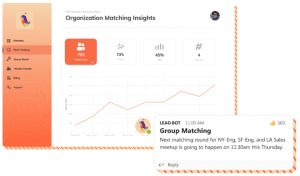Embarking on a mentorship program involves much more than simply assigning a mentor to a mentee. The process is complex, nuanced, and requires strategic planning to ensure success. It’s not a one-size-fits-all approach; instead, it is an investment that demands careful thought and the right resources to cultivate meaningful, productive relationships. Implementing best practices is critical, and leveraging technology tools, particularly within commonly used platforms like Slack and Microsoft Teams, can be game-changing. These platforms offer advanced features to optimize the matching process and elevate the overall mentorship experience. In this article, we delve into these best practices and how embracing the right software solutions can transform your mentorship program into an effective, dynamic powerhouse.
What are the 8 best practices for mentorship programs?
- Personalized Mentor-Mentee Matches: Manually matching mentors and mentees based on their personalities, work styles, and other factors can result in a more effective and successful mentoring relationship.
- Different Formats of Mentorship: Don’t limit mentorship programs to the traditional one-on-one model. Consider reverse mentoring, where senior employees learn from junior ones, or group mentoring, where one mentor guides a group of mentees.
- Training and Support for Mentors: Just as mentees require support, mentors also need resources and training to effectively guide their mentees. This can include support groups, leadership development classes, and other resources to develop their mentoring skills.
- Setting Clear Expectations: Define what the mentorship relationship should look like. For instance, establishing regular check-ins or other communication norms can help maintain a strong mentor-mentee relationship.
- Feedback and Improvement: Regularly evaluate the progress of the mentorship program. Encourage mentees to provide feedback about their experience. This can help identify areas where mentors might need to improve.
- Leveraging Technology: Use applications like LEAD.bot to facilitate and manage mentor-mentee matches, fostering effective and long-lasting mentorship programs.
- Building a Strong Community: Ensure that the mentorship program serves as a platform for building a strong community within the company. It should make new hires feel welcomed and well-oriented.
- Continual Learning and Development: Ensure the program is continually reviewed and improved based on feedback from participants and industry best practices.
As the business world rapidly evolves, so does the technology that supports it. One area experiencing a notable surge in innovation is employee matching. More than ever, companies are recognizing the value of cultivating relationships and collaboration amongst their staff. This rise of software for employee matching signifies a revolution in how businesses approach internal networking, mentorship, and team-building. Leveraging advanced algorithms and nuanced parameters, these innovative platforms are designed to foster meaningful connections within a workforce, enhancing productivity, morale, and overall company culture. As we delve into this article, we will explore the intricacies of these game-changing tools, highlighting their impact on modern workplace dynamics.
How automated matching software integrated within Slack or Microsoft Teams can revolutionize your mentoring process?
Utilizing employee matching software for mentorship, especially in platforms like Slack and Microsoft Teams, can provide several key benefits:
- Efficient and Accurate Matching: Manual pairing can be a time-consuming and potentially subjective process. An automated system uses data and algorithms to make accurate matches swiftly, based on predefined parameters, such as interests, skills, or roles.
- Scalability: As the organization grows, coordinating a mentorship program manually can become increasingly challenging. Automated matching software easily scales, ensuring that all employees, regardless of the size of your organization, have access to effective mentorship.
- Integration with Existing Systems: Slack and Microsoft Teams are widely used for internal communication within many organizations. Utilizing a matching software that integrates with these platforms streamlines the process and promotes active participation by making mentorship a part of the daily communication flow.
- Monitoring and Evaluation: Employee matching software often comes with built-in tools for tracking and assessing the effectiveness of the mentorship program. This can be instrumental in continually improving the program over time.
- Flexibility and Customization: Matching software often allows for a high degree of customization to suit your organization’s unique needs, whether it’s a traditional one-to-one mentorship, group mentoring, or speed mentoring.
What is LEAD.bot?
LEAD.bot is a dynamic employee-matching app designed to enhance speed mentoring programs within businesses. It enables HR managers and administrators on platforms like Slack and Microsoft Teams to quickly and efficiently pair mentors and mentees, streamlining the creation of impactful speed mentoring initiatives. This tool is intended to foster meaningful connections, boost engagement, and enrich the overall company culture.
Leverage LEAD.bot to optimize your mentorship initiatives, streamline your onboarding process, and enhance other employee matching strategies.
Sometimes, a thoughtful, personalized touch in workspace socialization can make all the difference. This is where LEAD.bot’s manual matching shines. It empowers HR managers and Slack admins to select specific users and pair them, using our admin dashboard. This powerful tool is not only beneficial for mentorship programs and onboarding processes but also fosters employee career development and enhances the overall work culture.
At LEAD, we’ve discovered that while random employee pairing fosters socialization, personalized matches are the key to effective peer mentoring. Are you ready to transform your workspace? Continue reading to discover how manual matching can empower your employees and significantly improve mentorship initiatives.
Stay tuned for actionable tips on implementing successful mentorship programs and an in-depth guide on utilizing our novel manual matching features on Slack and Microsoft Teams.
Unveiling Hidden Gems – Vital Considerations for Mentorship Programs!
1. The Numbers on Mentoring
Mentorship programs are great for mentors as well as mentees. Mentors are 6 times more likely to be promoted and feel as though their work is appreciated by their colleagues than their non-mentor counterparts.
On a company-wide level, mentorship programs improve company culture and increase productivity. According to Guider, 67% of companies report increased productivity due to their mentorship programs and over half, 55%, of companies believe that it has had a positive impact on their bottom line. Moreover, mentoring programs have amazing effects on diversity, inclusion, and representation in companies. These programs have improved the representation of marginalized groups on a management level, from 9% to 24%.
While we often think of mentoring as an onboarding tool, it isn’t just for new hires: Strong mentoring programs can improve retention for long-standing employees as well. Peer mentoring, a relationship between employees at the same lateral level in the organization, has been shown to improve retention rates, employee engagement, and employee satisfaction and alleviate loneliness.
Now that we know why workplace mentoring is hugely beneficial, let’s dive into the different formats mentorship programs can take.
2. Why Mentorship Is Best For Your New Hires
While workplace socialization is a plus for veteran employees, it’s a must for new hires. It’s easy for new folks to feel left behind, especially in a remote work environment, which has consequences. According to SHRM, most employees decide whether to stay or go within the first six months. In fact, Glassdoor found that a good onboarding process can improve retention by 82%. For remote working environments, the stakes are even higher: new hires lack a personal connection and have an even harder time asking questions.
So we know that a good onboarding process can set your promising new talent up for success, but what is a good onboarding process anyways?
A good onboarding process is all about making employees feel welcomed and well-oriented. According to a questionnaire of 1000 workers conducted by BambooHR, a third said they had quit within six months of starting. Of that third, 21% said that proper training would have helped them stay at the job and 17% said a friendly face, like a helpful coworker, would have made them more likely to stay.
From these statistics, it’s clear to see that adding a personal touch to onboarding is vital. However, it can’t just be managers who reach out.
As much as managers might want to step in and help their new employees out, most new hires might hesitate to ask for what they need – even if their fear of speaking up is based on unfounded assumptions. Employees are much more likely to open up to someone who is present in their day-to-day and is in a similar position than open up to their managers, even if their manager is willing to listen.

This is where a structured employee mentoring program comes in. With a good employee mentoring program, you can give your new hires a community within the company as well as a long-term trainer. Not only can a mentor help train their mentee, but they also start building a personal relationship with their new hire.
3. Rethinking the Traditional Mentoring Model
When we think of mentoring, we might think of a pair like Alexander the Great and Aristotle: an old wizened teacher and his carefully cultivated student. While some aspects of this kind of relationship remain, modern mentorships don’t have to be so rigid and one-sided.
There are some aspects of mentorship that haven’t changed. Mentors should be carefully selected and matched to their new mentees. No matter what level of employee they are interacting with, mentors should be high-potential performers who have strong interpersonal skills. According to Justworks.com, managers should also consider a potential mentor’s work history as well as their colleague’s opinions on the mentor’s performance. Getting a 360 view of the employee will ensure that mentors are well suited for their role and that their mentees will be in good hands.
Make sure your mentees’ personalities and work styles are matched to a mentor with compatible competencies. This data-driven match approach can be accomplished with a questionnaire for each mentor and mentee pair. As for implementing this data, here are a couple of ways to go about the matching process: match mentors and mentees based on their similarities or match mentors and mentees on their differences.
4. Reverse Mentoring
Matching mentors with mentees’ strengths might appear to be the most obvious and best choice, but mentoring partnerships can go both ways. Reverse mentoring is where senior employees receive learning opportunities from their juniors. Reverse mentoring is on the rise, as it presents an opportunity for younger employees to be active in the mentoring process. Although mentors are typically seen as role models, the millennial generation has shown how traditional mentoring models are in some ways becoming obsolete, as for many organizations, reverse mentoring refreshes leaders with new perspectives on the rising trends of technology or the future of work.
Usually, the reverse mentoring model is better for peer mentors because both mentor and mentee have generally been at the same company for a while. However, it’s worth considering all mentorship programs because the millennial generation has been producing skilled and experienced workers. Workers under 30 are digital natives since their high school years and are often more adept at adopting and implementing new tech than their older coworkers.
Group Mentoring
 Another model to consider is group mentoring, where one mentor is assigned to a group of mentees. Although there is something literary and romantic about a one-on-one master and protege relationship, group mentoring is a great way to provide mentoring opportunities for a larger cohort of people. In fact, group mentoring can also include peer mentoring opportunities between the mentees, as they can learn from each other. Group mentoring is a great option for providing high-quality professional development opportunities for large groups without putting a huge strain on human resources.
Another model to consider is group mentoring, where one mentor is assigned to a group of mentees. Although there is something literary and romantic about a one-on-one master and protege relationship, group mentoring is a great way to provide mentoring opportunities for a larger cohort of people. In fact, group mentoring can also include peer mentoring opportunities between the mentees, as they can learn from each other. Group mentoring is a great option for providing high-quality professional development opportunities for large groups without putting a huge strain on human resources.
Improving Your Mentorship Programs
 We know implementing a mentoring program reaps huge benefits, but that doesn’t mean you can let your team members lose. No matter what mentoring model you plan on implementing, program participants need help kicking off their mentoring experience.
We know implementing a mentoring program reaps huge benefits, but that doesn’t mean you can let your team members lose. No matter what mentoring model you plan on implementing, program participants need help kicking off their mentoring experience.
Just as mentees need support, so do their mentors. We often think of mentees as the ones who need training, but mentors also need mentoring resources. To foster strong mentoring relationships, make sure you’re giving mentors the right resources, including support groups with other mentors in the company and leadership development classes. Mentors need to learn a plethora of new skills for their new role, such as strong communication skills, giving constructive feedback, and problem-solving for their proteges.
Mentors will also benefit from having a clear set of expectations about what their mentoring relationship should look like. For example, establish requirements such as holding weekly check-ins, and deciding if those check-ins happen virtually or face-to-face. Mentors would also benefit from their mentees filling out program evaluation questionnaires so that mentors can get a sense of where they might need to improve their program.
Sharing a list of mentoring activities for mentors to bond with their mentees can be a significant help and a nudge in the right direction. A great resource for virtual mentoring, in particular, is a matching program like LEAD.bot.
Using LEAD to Improve Your Mentorship Programs
Ready to start your mentorship programs? You’ve come to the right place!
LEAD.bot, the employee-matching app, is capable of matching mentors right to their mentees with our manual matching feature for Slack and team matching feature for Microsoft Teams. While the personalized matching feature is slightly different for each messaging system, both of them will help you run long-lasting mentorship programs.
If you haven’t downloaded LEAD yet, start by downloading LEAD.bot for Slack or Teams at our website, LEAD.app.
LEAD.bot for Slack supports manual matching, which is a feature that allows you to individually assign matches. You can implement manual matching by accessing the advanced dashboard. To get there, click on LEAD.bot under “Apps” on the left-hand side of the chat window. From there, the “Advanced Dashboard” button will take you to a new window where you can choose a channel and match people within that channel. We recommend you invite all mentees and mentors into one channel so that this process is a little faster.
LEAD.bot for Microsoft Teams supports cross-team matching, where you can match people based on which team they are a part of – this means that LEAD.bot will not provide matches between people on the same team. To access this feature, add LEAD.bot to each team you would like to match. For your mentoring program, we recommend creating separate teams for mentors and mentees. After you have added LEAD.bot to each team, type “dashboard” into LEAD.bot. In the dashboard, click on “Match Settings”, which will take you to the cross-team matching window.
Now that you have your mentor-mentee matches, check out our blog or take a peek at our icebreakers for more ideas on how to get your matches connecting.
Have any questions, comments, or concerns? Check out our FAQ on LEAD.app, or reach out to us at hi@lead.app. We promise to get back to you within 24 hours!






